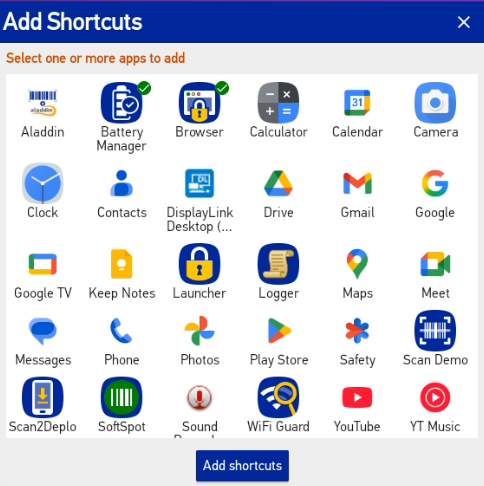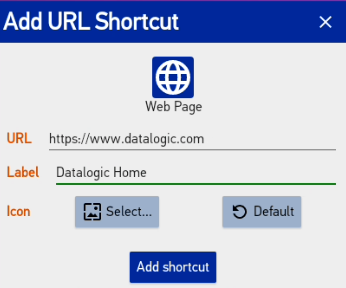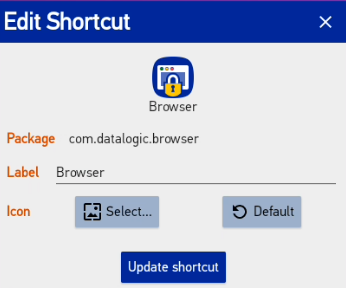Shortcut Settings
Overview
The desktop displays shortcuts for launching apps or URLs without opening the Apps menu. The list of shortcuts can be configured by selecting an option from various context menus that appears when you right click either the wallpaper or a specific shortcut. The following sections describe the steps you take to configure the shortcuts.
Access to the context menus is blocked while configuration settings are locked by an Administrator password. If nothing happens when you right click on the desktop, go to WorkDesk Settings from Apps menu and enter the Administrator password when prompted.
Show/Hide Standard Shortcuts
By default, the standard shortcuts (Settings, Chrome, Files) are displayed at the start of the list. To hide these shortcuts, right click on one of the standard shortcuts and select Hide standard shortcuts from the context menu. To show them, right click on the wallpaper and select Show standard shortcuts.
Add application shortcuts
To add application shortcuts, right click on the wallpaper and select Add app shortcuts from the context menu. This presents a dialog listing all apps that are not currently shortcuts.

Click on one or more apps to add as shortcuts. Each time an icon is clicked, it will toggle a green check to indicate it will be added. Once all apps have been selected, click the Add shortcuts button to add all selected apps as shortcuts.
Add URL shortcuts
To add shortcuts that launch a URL (web page), right click on the wallpaper and select Add URL shortcuts from the context menu. This presents a dialog for defining the shortcut.

The top of the dialog shows a sample of the shortcut as it will appear on the desktop. The following shortcut properties can be set:
| Property | Description |
|---|---|
| URL | This is the URL to the web page the browser should go to when launched. http:// will automatically be assumed if the scheme is not included in the URL. This must be non-empty to add a shortcut. |
| Label | This is the user-friendly name displayed with the icon on the desktop. |
| Icon | These buttons select the icon to display. Clicking on Select... presents a window which lets you select an image to use as the icon. The images shown to select from are taken from the public "Downloads" and "Pictures" folders on the device. These are the locations where image files are typically downloaded from a browser (or similar application), and can be viewed by launching the standard Files application on the device. Supported image file types are PNG, JPG and BMP. To revert to the default icon, click the button marked Default. |
Once all settings are defined, click the button Add shortcut to add the URL shortcut to the list. The dialog will remain open to add more URL shortcuts if desired.
Edit a shortcut
To edit an existing (custom) shortcut, right click on it and select Edit shortcut from the context menu. This presents a dialog for modifying the shortcut.

The top of the dialog shows a sample of the shortcut as it will appear on the desktop and provides controls that behave as described in the previous section (for creating URL shortcuts). When all changes have been made, click the button Update shortcut.
Remove a shortcut
To remove an existing custom shortcut, right click on it and select Remove shortcut from the context menu. After confirming the delete, the shortcut will be removed.
Changing the order of shortcuts
The order of the shortcuts can be altered. First, move the mouse cursor over the shortcut you wish to move. Then hold down the left mouse button, drag the shortcut to a new position in the list, and finally release the mouse button.
The standard shortcuts in the list are forced to be the first items in the list. Their positions cannot be moved, and any attempt to move a shortcut before it in the list will result in placing the shortcut immediately after the standard shortcuts in the list.